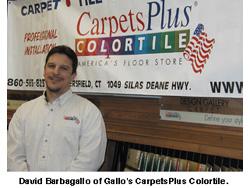Best Practices - March 2007
By Sonna Calandrino
Gallo’s CarpetsPlus Color Tile in Wethersfield, Connecticut tells two of America’s best stories. First is how a family of new arrivals to this country created a successful business here by practicing the axiom that catering to a customer never goes out of style. And second is how the company continues to evolve by developing and keeping customers. Copyright 2007 Floor Focus Inc
We first met the owner at the Home Décor and Fine Furniture Show in Hartford last fall. He was so busy with customers that he couldn’t talk with us about the keys to the business’ success.
Later, we did get some time from David Barbagallo, who told us of how his parents came from Italy and began an upholstery business. That upholstery business evolved into Gallo Home Interiors by adding window treatments, furniture and decorating. David credits his mother’s design and decorating skills for the growth of the customer base. David said from the age of five he learned to strip furniture, put on upholstery bottoms and tufting, and started to learn how to become a successful customer-oriented business by making business personal.
After his parents divorced in 1994, David and his mother, Lorraine, bought a Color Tile franchise, which evolved into Gallo’s CarpetsPlus Color Tile. Lorraine brought her expertise in design and decorating to the table, and David contributed his education (a degree in marketing management), knowledge of the customer, sales, measuring and installation.
“We found that small is okay,” David said, “because it gives us a chance to devote personal time to each customer and, in turn, develop and keep a customer base. Bigger is not always better. Create your own niche.”
He explains his formula this way: “It’s all about knowing your customer and your market—and benchmarking. Our customers typically are ages 45 and up.” The local flooring and interior design market is more mature, largely “re-dos,” not new construction. Redecorating is not as affected by swings in the economy, David maintains. Finally Gallo’s customers are not Lowe’s or Home Depot customers. “They don’t want to do it themselves!” David says.
Gallo’s understands that its customers want to know what their options are in flooring and recognizes that there are no simple choices. They also know they should design around flooring because it’s “more of a design element these days.” But store owners also need to recognize that the customer is overwhelmed, doesn’t know where to start and wants the whole process made easier and more personal. “Business today is more than the right product at the right price,” David says.
Speaking of competitive pricing, David adds, “Retailers shouldn’t be afraid to explain to their customers why they are paying a higher price—if that turns out to be the case. Review with them the true costs of doing business with new competitors like home centers and over the Internet. Explain shipping costs, and most of all that you have someone qualified to discuss a product, which the customer knows is not inexpensive. Also discuss the expectations the customer has regarding the final, lasting installation. Explain that your pricing is built on your level of services and skilled designers and installers, broad product availability and quality. Explain your strengths, such as warranties, policies, and services. Show the value of your prices.”
David makes every customer contact as personal as possible. When selling, measuring and estimating, he dresses in business clothes. As installer—yes, installer—he appears at the door as a clean-cut craftsman. Why? David recognizes that every customer contact is a “sales call” in that home. Though he personally installs two days a week, he checks on his installer crews, thus setting a professional example in his appearance, skill level and management style. By getting more involved in the installation process, he gets more respect from his installers.
Once in the house to measure, get to know the customer, he advises. Ask questions about their lifestyles. David makes it a practice to know customers’ interests and plans for their home. The more they share their plans and the more he gets involved, the more the customer sees the store appreciating the customer and the more business Gallo’s CarpetsPlus Color Tile writes.
So, what were David Barbagallo and Gallo’s CarpetsPlus Color Tile doing at that high end fall home show at the new Hartford Convention Center? The one where he was so busy he couldn’t do an interview? Getting more customers.
“This kind of advertising is measurable!” he says. “We get plenty of leads.” But he warns that going to a home show means work, getting out there and talking with customers, getting involved. “Too many exhibitors just attend these shows and fail to understand they have to take the initiative and network with customers by talking with them.” It’s also an opportunity to network with tradespeople in aligned businesses. These events are so successful that David invests in Fall and Spring shows.
His advice? “When business is bad, these shows are essential. You will get jobs and connections, especially those business connections, with anyone that has to do with the home environment. They’ll lead you to jobs and help keep you up to date on new products.
“When business is good and you feel you don’t have time, make time! These events keep you up to date on new products and what’s going on in home décor.”
This year David’s goal is to refine costs for direct mail and to develop private sales customized to Gallo’s market. David advises, again, that these can be effective customer-builders, but know your costs and be aware that the results will be invaluable as he builds his customer database. Among his targets will be the area’s new gated communities. He’s also looking to do a modest showroom remodeling to feature more kitchens, baths and room vignettes to showcase his products and interior design skills.
Related Topics:Carpets Plus Color Tile, The International Surface Event (TISE)
